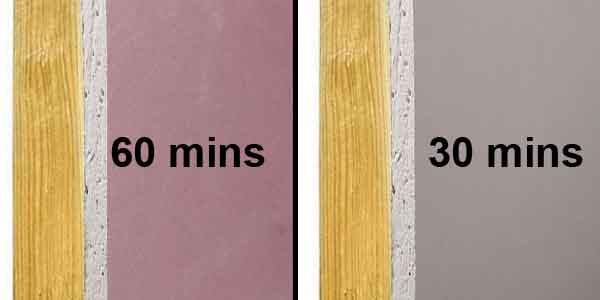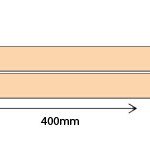A fire in the home is a nightmare scenario for anyone. Most people will take the standard precautions, such as avoiding open flames where possible, and having fire alarms installed.
There are also building materials that can help to contain fire and stop it spreading as quickly. One of the first that springs to mind, is fire doors. These usually have a fire rating of 30 minutes (FD30) or 60 minutes (FD60)

However, what about the wall that the door is fitted in? For example, a solid stone, block, or brick wall, will generally have a longer fire-resistant rating than a FD60 door. But what about a stud wall? These are usually made of timber (which is highly flammable).
So, is a stud wall fireproof? And if so, how long will it last?
A standard stud wall with 12.5mm plasterboard on either side, will have 30 minutes of fire resistance. On the other hand, if you opt for fire resistant plasterboards (pink faced boards) your walls will have a rating of 60 minutes.
If you have fire doors installed, it will usually make sense to have a wall with the same fire rating. Therefore, a wall with a 60-minute fire door, would usually have 60-minute plasterboards.
Regulations in residential property tend to have a 30-minute requirement for most areas of a property. However, the dividing wall between two properties must be at least 60 minutes.
Often in older properties, you will find no dividing walls in the loft space between homes. In this case, you should fill the opening to the underside of the roof. This could be achieved with studwork and fire-resistant plasterboards.
Ways to increase stud wall fire resistance
As we already know, a stud wall fitted with a fire-resistant board, will give you double the protection of a standard board.
However, there are several other ways you can increase the fire resistance of a stud wall. Some of the most common ways can be seen below:
Doubling up boards
A standard 12.5mm plasterboard, will only give 30 minutes of fire resistance. However, doubling the board will give over 60 minutes. If you were to double two 15mm standard boards, this could give as much as 90 minutes.
You could also double up fire resistant boards. Installing two 12.5mm fire resistant boards, will provide up to 2 hours of protection.
Stagger plasterboard joints
Generally, this is best practice anyway, as continuous joints can be bad for the finished plaster. However it will also help to reduce the speed the plasterboard fails in a fire.
This can be even more effective when doubling boards. As joints will not be on top of each other.
Also, ensuring your joints are landing on either studs or noggins will help
Use thicker plasterboard
15mm boards will last slightly longer than 12.5mm boards
Reducing gaps and holes
Common holes in walls, include those made for installation of electrics, such as switches and sockets. These should be cut out accurately, with the face fitted back securely to the surface. You can also buy various fire rated inserts for electrical instillation. These create a seal and can provide up to 2 hours fire resistance.
Use metal studs
Metal stud work is an option. Obviously, the metal is not flammable. It is also heat tested, in order to withstand high temperatures without failing.
Install insulation
Fiberglass insulation such as rockwool, and sheet insulation such as Kingspan, offer additional resistance to fire. Both are non-combustible products. Also, tests carried out on Kingspan Kooltherm K12, saw 49 minutes fire resistance in a standard stud wall.
Any of the above will increase the amount of time a wall lasts in a fire.
In most residential properties, 30-60 minutes of fire resistance will be sufficient. However, if you want extra fire resistance in a wall you are building, you can follow any of the tips above to increase a stud walls resistance to fire.
Are old stud walls fire resistant?
In many older properties, the stud walls will be constructed using timber and finished with lathe and plaster.
This is an old technique for plastering walls. It was widely used before modern plaster and plaster boards. The lathe and plaster consists of thin strips of wood nailed to the studwork. These strips of wood are then coated in layers of lime plaster.
This type of stud wall will not be as effective and will generally provide around 20 minutes resistance to fire.
The level of fire resistance, could also vary significantly, based on the age and condition of the plaster. Many unknown factors could influence how effective the surface is at resisting fire.
Conclusion
Even standard stud walls, using a 12.5mm plasterboard are fire resistant for up to 30 minutes. There are many things that can be done to improve this fire rating. Some of the most common are fire resistant boards and insulation.
If you need any help with fire regulations, you can check the governments approved fire safety documents here.
You can also check building regulations and talk with your local fire safety officer.




